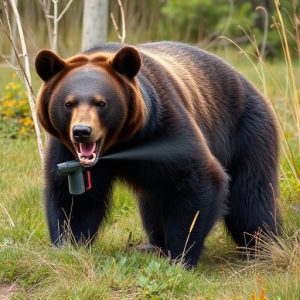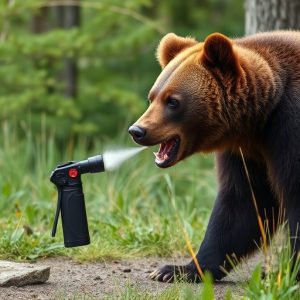Bear Spray Safety: Preventing Accidental Discharges During Wildlife Encounters
Wildlife encounters, especially with bears, demand education and precautions for human safety. Bear…….
Wildlife encounters, especially with bears, demand education and precautions for human safety. Bear spray is a vital tool, deterring bears through odor and sensation, but accidental discharges can escalate situations. Preventive measures include proper handling, awareness of bear behaviors and danger signs, responsible usage, and regular training to ensure safe interactions while preserving wildlife habitats. Accidental bear spray discharge prevention involves understanding the spray's range, practicing deployment until second nature, using reputable brands with safety locks, and calm, targeted application during encounters.
In the wild, unexpected wildlife encounters can quickly turn from awe-inspiring to dangerous. Understanding these risks is crucial for outdoor enthusiasts. This article explores how bear spray serves as a vital tool in protecting you during such interactions, focusing on its role and effective use. We delve into common causes of accidental bear spray discharge prevention techniques, offering insights to ensure safe and responsible wildlife appreciation. Learn the right choices and practices to make every outdoor adventure more secure.
- Understanding Wildlife Encounters and Their Risks
- The Role of Bear Spray in Protecting You
- Accidental Discharge: Common Causes and Prevention Techniques
- Choosing and Using Bear Spray Effectively
Understanding Wildlife Encounters and Their Risks
Wildlife encounters, especially with bears, can be unpredictable and potentially dangerous. While these interactions are often fleeting, they require a deep understanding to ensure human safety. Many outdoor enthusiasts and hikers embark on adventures into bear country without realizing the risks involved, which is where proper education and precautions become paramount. An accidental bear spray discharge, for instance, could escalate a situation from mere curiosity to a life-threatening crisis if not managed correctly.
Preventing such mishaps demands awareness and preparation. Bear spray, a potent deterrent, should be handled with care to avoid unexpected discharges. Understanding the mechanics of these encounters, their behaviors, and how to respond appropriately is crucial. By learning about bear habits, recognizing signs of potential danger, and practicing responsible usage of deterrents, individuals can minimize risks during wildlife viewing experiences, ensuring both their safety and the preservation of these magnificent creatures in their natural habitats.
The Role of Bear Spray in Protecting You
Bear spray, also known as bear repellent, plays a pivotal role in protecting individuals from potential bear encounters, especially when hiking or camping in bear country. Its primary function is to deter and discourage bears, particularly grizzly bears and black bears, from approaching humans. The spray is designed to create an unpleasant experience for the bear through its strong odor and peppery sensation, causing the bear to retreat and avoid contact.
One of the key benefits of bear spray is its ability to prevent accidental discharges during critical moments. Proper usage includes holding the can upright, spraying in a sweeping motion towards the bear’s face and body, and keeping the nozzle aimed at the target. Training and practice are essential to ensure users can effectively deploy the spray when needed, minimizing the risk of accidental discharge, which could potentially escalate an encounter or cause harm.
Accidental Discharge: Common Causes and Prevention Techniques
Accidental discharges of bear spray can occur for various reasons, often due to a lack of awareness or improper handling. One common cause is misjudging the distance to an approaching bear, leading to an overzealous trigger pull. Users might also accidentally activate the spray when reaching for it in a hurried situation, especially if they’re not accustomed to its deployment mechanism.
To prevent these incidents, it’s crucial to familiarize yourself with the spray’s range and de-sensitize yourself to the activation motion. Practice makes perfect—rehearse the proper technique until it becomes second nature. Always keep the spray in a secure, closed container when not in use, and ensure the nozzle is directed away from you and any potential hazards. Regular training sessions can significantly reduce the likelihood of accidental discharges during a wildlife encounter.
Choosing and Using Bear Spray Effectively
When choosing bear spray, look for products approved by reputable organizations like the National Park Service or various outdoor recreation associations. These sprays are designed to be effective against both black and grizzly bears while ensuring user safety. Check for factors like can size, spray range, and concentration of capsaicin, the active ingredient. Always select a can with a safety lock to prevent accidental discharge.
Proper usage is key to bear spray’s effectiveness. Keep the can in an easily accessible pocket or belt clip while hiking or camping. When faced with a bear, remain calm and raise the can above your head. Point it towards the bear and spray in short bursts, aiming for the bear’s face and eyes. Back away slowly after spraying, ensuring the bear is deterred without causing harm. Practice using the spray in controlled environments to familiarize yourself with its operation, as an accidental discharge can be dangerous both for you and wildlife.
Wildlife encounters can be awe-inspiring, but understanding potential risks is key. Bear spray has emerged as a valuable tool for protection, offering a safe and effective way to deter aggressive bears. By learning about accidental discharge prevention techniques and choosing the right bear spray, you can enhance your safety in these situations. Remember, proper usage and knowledge of these devices are essential to navigating wildlife encounters confidently and securely. Implement the strategies outlined here to minimize risks and enjoy a more peaceful experience in nature.


